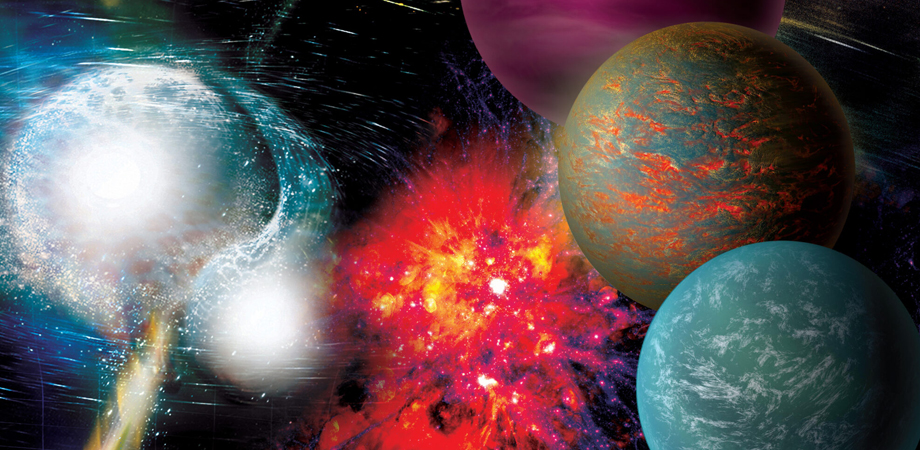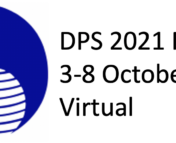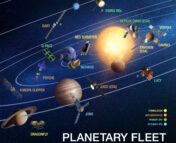Welcome to the Astrobites coverage of the 2022 April APS Meeting! Some of our authors this week will be in-person while others are attending virtually! We will report on highlights from each day here, from APS Press Conferences to graduate student research talks. If you’d like to see more timely updates during the day, we encourage you to search the #aprilAPS hashtag on twitter. We’ll be posting once a day during the week, so be sure the visit the site often to catch all the news!
Gravitational Wave Populations: Black Hole Mass & Spin Distributions (by Sumeet Kulkarni)
Believe it or not, it’s been 6 years since the LIGO collaboration announced the first ever detection of gravitational waves. During this time, joined by the European gravitational-wave observatory Virgo, the universe has been gradually raining gravitational waves at a rate of about one event per week while the ground-based detectors have been observing. In their latest gravitational-wave catalog, called GWTC-3, the LIGO-Virgo collaboration announced a total of 90 gravitational wave events, including two mergers of binary neutron stars (BNS), two involving a neutron star and a black hole (NSBH), and many mergers of binary black holes (BBH).
This morning’s joint APS DAP and DGRAV session chaired by Carl Rodriguez (Carnegie Mellon University) focused on determining the population properties of a whole catalog of black hole binaries, such as their mass and spin distributions. The session began by addressing the important question of observational bias: the fact that heavy and equal-mass black holes appear louder in our detectors and hence we see more of them, thereby skewing our understanding of what the actual population of black hole binaries looks like. Doga Vesky (Columbia University) introduced statistical relationships that can help us distinguish this bias from the metrics we used to determine a gravitational-wave detection, such as the signal-to-noise ratio. Following this, Simona Miller (Caltech) reported on the lack of evidence that a majority of the black holes that we have detected are non-spinning. This is promising because black hole spins, while very hard to measure, can carry a wealth of information, including clues to how their binaries form. In addition, Salvatore Vitale (MIT) presented a surprising anti-correlation between the mass ratio and spins of black holes in the existing population.

Rounding up the session was Davide Gerosa from the University of Milan with a back-to-the-future twist on measuring spins of binary black holes. A new paper by him and collaborators evolve the spin measurements of these systems back in time where the detectors are most sensitive, to an infinite separation or a frequency of 0 Hz. This is a close approximation to the point where the binaries actually formed, and places them on the same ground. Additionally, it removes selection bias in the astrophysical inference of black hole tilts.
It was exciting to have an entire session dedicated to populations of compact binaries, which really signifies the leap that the field of gravitational-wave astrophysics has made, transitioning from from the challenge of making the first detection to making sense of detections numbering by the dozens.
Live-tweeting of this session by Sumeet Kulkarni. Resources from this session (B15) will be available to registered April APS attendees until July 12, 2022 at the link here.
Accretion Across the Mass Scale (by Briley Lewis)
The APS Division of Astrophysics (DAP) sponsored another exciting session on the first day of the 2022 April Meeting, this time focusing on accretion disks. Three speakers shared about different ways accretion shows up around objects of varying sizes, exploring some of the big questions of the field and how they’re tackling them.

Krista Lynne Smith, Assistant Professor at Southern Methodist University, gave a talk about accretion around Active Galactic Nuclei (AGN). Different parts of AGN can be observed with different wavelengths, and we have many observatories that can tackle these different parts of the problem. AGN are also “variable at all wavelengths, and over a huge range of timescales,” says Smith, showing two light curves: one with variability over 4 hours, and another over 8 years. We even have evidence that AGN can vary on timescales longer than what humans can observe, over 10,000 years. One of our best ways of probingg this accretion and observing this variability is known as timing, capturing the changes in light with very high precision.
Although Kepler was known for exoplanet-hunting, it was also useful for timing AGN since it had such unparalleled photometric capabilities. This led Smith to create the Kepler-Swift Active Galaxies Survey (KSwAGS), using the Swift X-ray satellite to survey the Kepler field, searching for AGN. They identified multiple AGN, and found power spectra with steeper slopes than they’d expect from usual models. Other researchers found a new model that could explain these observations, where the disk and the corona of the AGN are coupled by the magnetic field (known as corona-heated accretion disk reprocessing). Smith is looking forward to new observations with Kepler’s successor TESS, but does caution that the standard data pipeline isn’t meant for AGN — so she made “QUAVER: A TESS Pipeline Optimized for AGN” to solve this problem!
Tom Maccarone, Professor at Texas Tech University, echoed Smith’s calls for variability studies. For AGN jets, we generally can’t resolve them, so the only way to tease out their structure is with variability across many wavelengths. We have many open questions about jets, including: how are they launched and collimated? Does the black hole’s spin matter? Time lags between the different wavelengths of light can reveal AGN structure, so measuring multiple wavelengths simultaneously is key to piecing together this puzzle — JWST is going to be a great help in this, and, if selected as NASA’s probe-class mission, STROBE-X would, too!
Smith also mentioned Quasi-Periodic Oscillations (QPOs), a feature commonly seen in the power spectra of smaller accreting black holes but less so in AGN. This leads to the question: are QPOs actually rare, or have we just not found them yet because of our technological limitations? If there are actually fewer QPOs in bigger black holes, this could pose a problem for scale-invariant accretion—the idea that accretion follows the same basic principles at all sizes. Stellar mass black holes, where we’ve seen most QPOs, usually radiate in the X-ray (where we’ve been looking!) but AGN radiate most in UV/Optical…so maybe we’ve just been looking in the wrong place!
Dheeraj Pasham, Research Scientist at MIT, is also interested in QPOs — just at a slightly different scale. He’s been thinking about how Extreme Mass Ratio Inspirals (EMRIs), a smaller object spiraling in towards a larger one, could be a part of this picture of accretion. EMRIs are also related to Tidal Disruption Events (TDEs), and these encounters can end in multiple ways: partial disruptions, binary stars, and even so-called “zombie cores.” Their simulations also suggest that EMRIs might be able to drive outflows, producing QPOs as the smaller object oscillates in its orbit. Pasham emphasized how much there is to look forward to in this field, especially with large ground based surveys like Rubin, the European X-ray mission Athena, and the future gravitational wave detector LISA.
Live-tweeting of this session by Briley Lewis. The recording of this session (D03) will be available to registered April APS attendees until July 12, 2022 at the link here.
Overview of the Astro2020 Decadal Survey (by Huei Sears)
The Astro2020 Decadal Survey (commonly shortened to ‘the Decadal’ or ‘Astro2020’) was finally released this past November, offset by a year due to worldly circumstances. Titled “Pathways to Discovery in Astronomy and Astrophysics for the 2020s,” this 600+ page document (which you can read here and even buy a paperback copy for $95) includes recommendations to funding agencies such as NASA & the NSF as to what to prioritize in the upcoming decade.
Prof. Julianne Dalcanton (who has a comet and an asteroid named after her) and Prof. Eliot Quataert, both members of the Decadal’s Steering Committee, gave some broad background on the Decadal Survey. Prof. Dalcanton’s talk offered a brief history of the Decadal, describing how committees are formed and utilized in crafting this document, and offering a few examples of how very broad scientific interests are narrowed into specific concrete recommendations to funding agencies, such as NASA and the NSF. Prof. Quataert’s talk built upon the examples offered by Prof. Dalcanton and went into detail about how the proposed astronomical interests would support other areas of physics. Of course astronomy is linked to physics, and so inherently all astronomical interests will support other areas of physics. The speakers wanted to highlight what overlaps most with areas the physics community is independently engaging in (e.x. what are condensed matter physicists studying that we, as astronomers, can also study?). One of the areas they chose to detail was one of the main priorities of Astro2020: “’New Messengers and New Physics.” They explained how astronomical observations can lead to new physics with examples such as IceCube’s detections of high-energy neutrinos and the LIGO/Virgo detection of gravitational waves (and the detection of electromagnetic counterparts!).
This session also featured an invited talk by Prof. Blakesley Burkhart, in honor of her winning the Maria Goeppert Mayer Award! Her talk, titled, “Advancing New Diagnostics for Turbulence in Astrophysics,” asked such questions as “What is turbulence? Why is it important for astronomy? How can we measure it? What resources can we use to measure it?” Turbulence is, as Prof. Burkhart put it, a “self-similar transport of energy across scales” that we can characterize by using statistical techniques on observational data to obtain a variety of parameters, including the kinetic energy, Alfven Mach number, and the Sonic Mach number, where a ‘Mach number’ is the ratio of flow velocity to the speed of sound in the observed medium. Prof. Burkhart points out that her research is closely related to the priorities of Astro2020 – specifically that of “Cosmic Ecosystems” and how stellar feedback into the interstellar medium reproduces stars. Turbulence is an essential tool of modeling this feedback loop as gas flow is inherently turbulent. You can read a previous Astrobites interview with Dr. Burkhart here!
Live-tweeting of this session by Huei Sears. The recording of this session (E03) will be available to registered April APS attendees until July 12, 2022 at the link here.

Featured Image Credit: Astro2020 Decadal Survey
Edited By: Sumeet Kulkarni, Briley Lewis, Huei Sears




